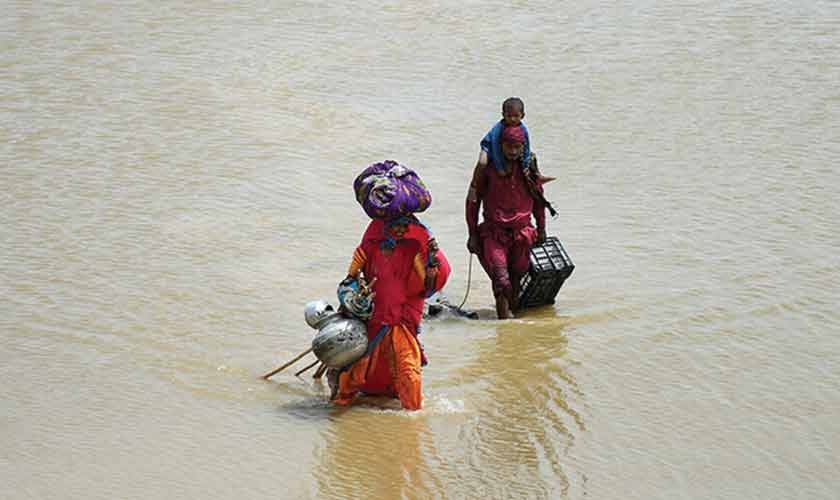The Monsoon of 2022: Beyond Physical Damage – Addressing the Mental Health Impact of Floods in Pakistan
The monsoon of 2022 brought torrential rains across Pakistan. Although the Meteorological Department had warned about possible flooding, the reality struck sooner than expected. Many areas of the country were submerged, and Sindh was no exception.
At that time, I had just assumed charge as Dean of the Faculty of Medicine at my university. The Vice Chancellor called an emergency meeting to discuss how we could contribute to relief efforts for the communities affected by the floods. Teams comprising doctors and paramedics were dispatched to provide first aid, food, medicines, and treatment for medical conditions anticipated in such disasters, including skin and eye infections.
As a mental health professional, I realized that addressing physical health alone would not suffice. Acute panic and deep psychological scars are often part of such calamities. After a brief training on psychological first aid, I sent medical officers, psychiatry trainees, and psychology interns to join our medical teams. This multidisciplinary team worked effectively on-site, but many patients needed ongoing treatment and were referred to hospitals in Hyderabad.
During this time, I met many individuals whose stories left a lasting impact on me. Among them was an elderly, lean man whose quiet tears spoke volumes. He seemed unable to express the many emotions and thoughts crossing his mind. A companion informed me that he had lost the dowry he had painstakingly saved for his daughter’s marriage in the flood. Without uttering a word, his grieving face revealed dreams washed away and a spirit broken by loss.
I also recall a mother who screamed every time she remembered her child drowning, and a farmer who lost his cattle – his entire livelihood swept away. Behind each individual case was a story of human pain and sheer helplessness. The floods not only dismantled homes and damaged crops but also swept away the hopes and peace of countless people.
The challenges did not end there. Within weeks, many who had helped flood victims began suffering from anxiety, sleep disturbances, and trauma themselves. This experience gave my team and me unforgettable insights into managing the multifaceted nature of grief.
Many survivors initially experienced shock; they felt numb and were unable to comprehend the devastation. Those who had helped others lived in intense fear—fear of losing loved ones, possessions, or facing hunger, disease, or another disaster. Overwhelming grief was common among those who lost family members, relatives, homes, and lifelong savings.
As people tried to rebuild their lives amidst instability and insecurity, some struggled with panic, anxiety, and sleeplessness. Post-traumatic stress disorder (PTSD) appeared in some, who relived traumatic events through flashbacks and nightmares. Others battled suicidal thoughts fueled by survivor guilt.
Imagine a white-collar worker, once living with dignity, now standing in a queue for food—his pride shattered and spirit broken.
Children accompanying families of psychiatric patients often showed withdrawn and fearful behavior, reflecting anxiety and confusion about their surroundings. Adults expressed irritability, helplessness, and emotional numbness. The elderly, already fragile, lost their sense of safety and belonging.
These deep psychological scars often linger long after physical damage is repaired.
Recognizing and treating emotional wounds is as vital as addressing physical injuries in disaster response. True recovery goes beyond rebuilding homes and providing food; it means restoring resilience, dignity, self-esteem, and hope.
If psychological wounds are neglected, healing remains incomplete. Fear, grief, despair, and shattered ego can prevent a person from fully recovering despite adequate physical healthcare. Emotional scars erode motivation, disturb sleep, and weaken the body’s resilience.
This reality concerns me deeply, especially since public attention and media coverage tend to focus more on physical health and infrastructure than mental well-being.
The flood of 2022 left us pondering: Can we not learn from such experiences and train ourselves to practically help those in distress? Rather than watching as bystanders—making videos or panicking—we can act with empathy by listening, connecting, and comforting those who have suffered, offering them a ray of hope.
Can our governments also support these distressed people in ways that protect their dignity and self-esteem, enabling them to become more resilient and capable of rebuilding their lives—and perhaps, helping others in turn?
The mental health dimension of disaster relief is not just an add-on; it is central to holistic recovery and the restoration of communities torn apart by tragedy.
https://www.thenews.com.pk/tns/detail/1350034-floods-washed-away-all-but-tears

Be First to Comment